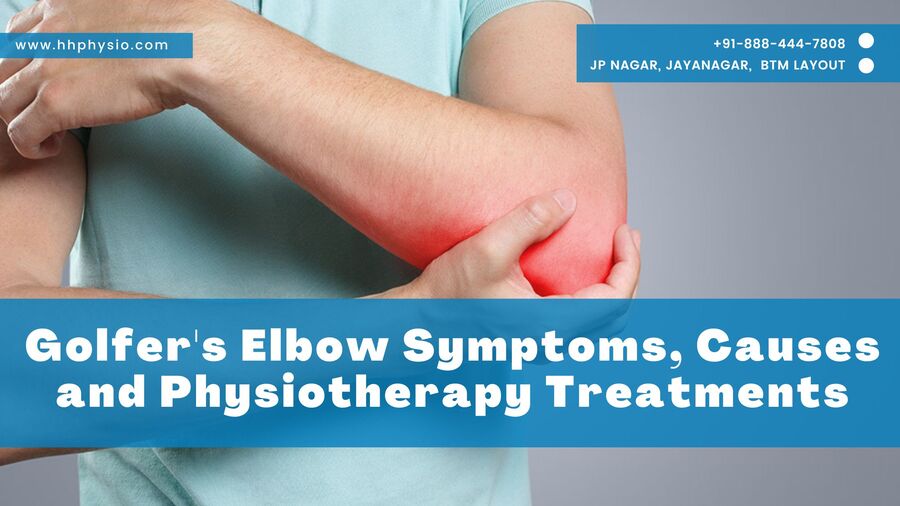Golfer’s Elbow Symptoms, Causes & Physiotherapy Treatments
Golfer’s elbow, also known as medial epicondylitis, is a type of overuse injury that occurs in the elbow region. It is a common injury that affects not just golfers but also other athletes and individuals who engage in repetitive activities that involve gripping and twisting movements of the wrist and forearm. In this blog, we will discuss the symptoms of golfer’s elbow and how physiotherapy can help in treating it.
Symptoms of Golfer’s Elbow:
Golfer’s elbow is characterized by pain and tenderness in the inner side of the elbow, near the bony bump known as the medial epicondyle. The pain may be mild at first, but it can gradually worsen and become more intense. Some common symptoms of golfer’s elbow include:
- Pain and tenderness on the inner side of the elbow
- Stiffness in the elbow joint
- Weakness in the wrist and forearm
- Pain when gripping or twisting the wrist
- Numbness or tingling in the fingers
- Pain that worsens with activity and improves with rest
Certainly! Here is an additional segment on the causes of golfer’s elbow:
Causes of Golfer’s Elbow:
Golfer’s elbow is caused by repetitive stress and strain on the tendons and muscles that attach to the medial epicondyle of the elbow. This can result in tiny tears in the tissue and inflammation, leading to pain and discomfort. Some common activities that can contribute to golfer’s elbow include:
- Golf: Repetitive swinging of a golf club can place stress on the elbow joint and forearm muscles, leading to golfer’s elbow.
- Racquet Sports: Sports such as tennis, squash, and badminton involve repetitive gripping and twisting movements of the wrist and forearm, which can contribute to golfer’s elbow.
- Weightlifting: Exercises that involve lifting weights can place stress on the forearm muscles and tendons, leading to golfer’s elbow.
- Typing and Computer Use: Repeated typing and mouse use can place strain on the wrist and forearm muscles, leading to golfer’s elbow.
- Other Activities: Activities such as gardening, carpentry, and painting can also contribute to golfer’s elbow if they involve repetitive gripping and twisting movements of the wrist and forearm.
It is important to note that golfer’s elbow can also occur due to sudden trauma, such as a direct blow to the elbow or a fall on an outstretched hand. In such cases, the injury may be more severe and require immediate medical attention.
Physiotherapy Treatment for Golfer’s Elbow:
Physiotherapy can be an effective treatment option for golfer’s elbow. A physiotherapist can design a personalized treatment plan that is tailored to the individual’s specific needs and goals. Some common physiotherapy techniques used to treat golfer’s elbow include:
Ice Therapy: Applying ice to the affected area can help reduce pain and inflammation. The physiotherapist may use ice massage or ice packs to provide relief.
Manual Therapy: Manual therapy techniques such as massage, joint mobilization, and stretching can help improve joint mobility and reduce pain.
Strengthening Exercises: Specific exercises to strengthen the forearm muscles and improve grip strength can help reduce the strain on the elbow joint.
Ultrasound Therapy: Ultrasound therapy uses high-frequency sound waves to promote healing and reduce inflammation in the affected area.
Taping and Bracing: Taping and bracing techniques can help support the elbow joint and reduce strain on the affected area.
Activity Modification: The physiotherapist may recommend modifying activities that aggravate the condition, such as reducing the frequency or intensity of the activity or using proper equipment and technique.
Conclusion:
Golfer’s elbow is a common overuse injury that can cause pain and discomfort in the elbow joint. Physiotherapy can be an effective treatment option for golfer’s elbow, as it can help reduce pain and inflammation, improve joint mobility, and strengthen the forearm muscles. If you are experiencing symptoms of golfer’s elbow, it is important to seek medical advice and consult with a physiotherapist to receive proper diagnosis and treatment. With proper care and treatment, most individuals can recover from golfer’s elbow and return to their regular activities.
Also Read: What to do after a muscle cramp?
Share it with others…

